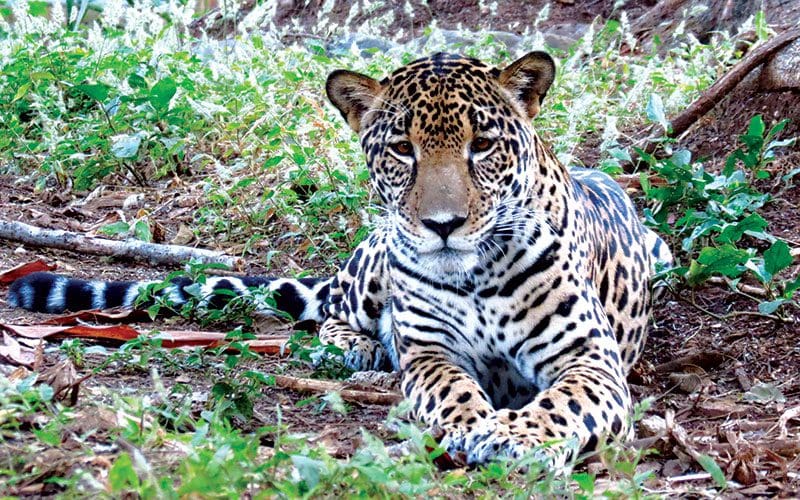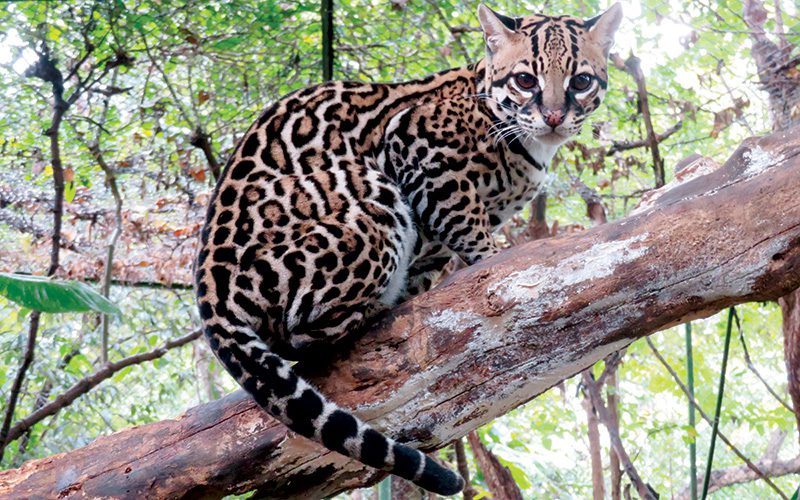
Las Pumas Animal Rescue Center Not Responsible for Cross-Species Love
I knew we would see big cats when we went to the Las Pumas animal rescue center in Cañas, Costa Rica. I didn’t know we would see a collared peccary in love with a three-legged deer.
But there they were in the same enclosure, the white-tailed deer hopping up to a feeding trough while the pig oddly licked her haunches and scratched her flanks with his nose. The deer’s name is Milagro (“Miracle”), and she was shot in the now-missing leg by a hunter. The peccary, Ñoño (“Fatso”) used to live in a cage at a hotel in Tilarán before the owner turned him in.
And then love bloomed. “They adore each other,” said Esther Pomareda, the resident biologist at Centro de Rescate Las Pumas.

Happy endings are not all that common in any place where animals live in cages, but their beginnings are often a lot worse. Esther gave us a tour starting with white-faced monkeys, where one came right up to us and started moving his mouth like he was imitating her spiel.
It has a campaign to
educate people to leave
baby animals alone.
A forlorn spider monkey came over and took up a perch on the fence, dropping her head and covering it with her hand like she was sad.
Esther said that at first the spider monkey was in another cage and was depressed and stressed, so they decided to put her with the capuchin monkeys to see how they got along. I remarked that she still looked depressed.
“All animals in captivity are going to be a bit sad or stressed, just for being locked up,” Esther said. “As much as we try to make the habitat nice and big, and leave them toys, they destroy them.”

Big cats
There are two jaguars here, three pumas, four ocelots, two jaguarundis and one margay. When we visited, most of them were doing what cats do best: sleeping.
But one gorgeous puma named Bruno was walking around like, well, like a caged puma. He was confiscated from some idiot who had a canopy tour with a cougar. It goes without saying that it’s totally illegal in Costa Rica to keep wild animals to attract tourists without the rigorous permits required by the environment ministry, MINAE.
The nonprofit Las Pumas was founded more than 50 years ago by a Swiss couple named Lilly Bodmer and Werner Hagnauer. It was recognized last year with an international certification from the Global Federation of Animal Sanctuaries — a distinction it shares with only one other refuge in Costa Rica, Zoo Ave.
“It demonstrates that the care and well-being of the animals, the quality of their health, the financing, everything meets all the norms and standards on an international level,” Esther said.
Under Costa Rican law, animal sanctuaries can put animals on public display only if they are deemed incapable of surviving in the wild — typically because of injuries or because they were raised as pets and are too habituated to humans. Rescued animals that can be rehabilitated and released are required to be kept away from human contact under a separate permit from MINAE. If you release a jaguar, you want it to go out in the jungle and hunt, not walk up to some farmer’s house looking for a handout.
Las Pumas has permits to do both — display animals that can’t be released and rehabilitate animals that can, away from the public eye.
Memorable rescues
Esther showed us an ocelot that was kept as a pet in a house and fed fried meat. “We had to teach him to eat raw meat,” she said. I imagined this spoiled cat saying, “I want Pollo Crispy!”
A beautiful jaguar named Curubanda showed up behind someone’s house in the Santa Rosa area when she was about 10 months old and already at death’s door, weak and extremely thin. The lady of the house called authorities, who showed up and picked up the cat.
“How did they pick her up?” I asked.
“They just put her in a cage with their hands,” Esther said. “She was so weak that they just put her in the kennel.”
Don’t try this at home.
“Curubanda is a jaguar with vision problems,” Esther said. “She’s cross-eyed and she sees shadows. She’s myopic, not completely blind, but she came to us like that. When they brought her here and examined her, she recovered. She had anemia and she was full of ticks.”
The hope was to release her, and since she was a wild animal, handlers offered her live prey like mice. “But they would run right between her legs and she wouldn’t hunt them,” said Esther. “Now she eats beef.” Cows are donated by local ranchers to become cat food, she said, and one cow can last four or five days.
Curubanda is also a painter, it turns out. Her handlers give her paint and she spreads it around on a canvas, and her “paintings” are auctioned off to raise funds.
Back in the 1980s there were two jaguars who were artists of another kind — escape artists who managed to break out of their enclosures. As you can imagine, nowadays this kind of behavior is strictly discouraged. Esther said one new jaguar enclosure cost $20,000 to build.
Your help may be unhelpful
Las Pumas has close to 60 parrots, toucans and scarlet macaws. There are some 15 turtles — Esther says people see a turtle crossing the road and they bring it here instead of putting it on the other side of the road.
“Of all the animals we receive, 50 percent are babies, and of those about 44 percent could have been left in the wild,” she said. Las Pumas receives as many as 160 animals a year of 46 different species. It has a campaign called ‘Don’t Take Me Out of My Habitat” to educate people to leave baby animals alone.
“A lot of people think the mother is dead, but in fact the mother is alive — she’s just hunting, she’s resting nearby, or she got spooked when people came,” Esther said. “We’re trying to educate people that when they find these babies, they should leave them alone.”
It’s a different story if the animal is in danger, threatened by dogs or by flooding, or if the mother never returns. Call SINAC or move the animal if you can do so safely.
“A very small percentage are animals where the mother really died — run over, electrocuted, different reasons,” she said.
But if you ever find a three-legged deer, please take it somewhere else. There is a pig here who could get very jealous.
For more info:
Website: centrorescatelaspumas.org
Phone: (506) 2669-6044, 2669-6019
Email: laspumas@racsa.co.cr
Address: 4.5 km north of Cañas on Inter-American Highway
Visit howlermag.com/laspumas

